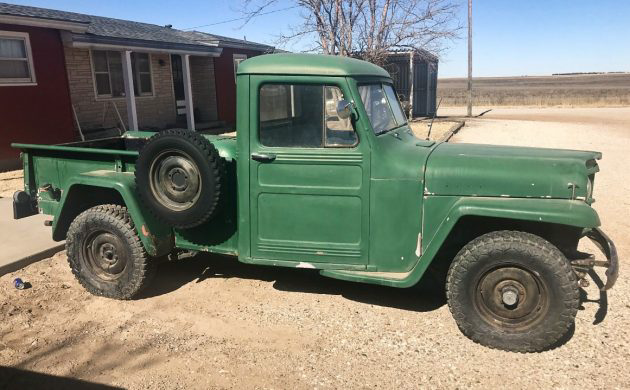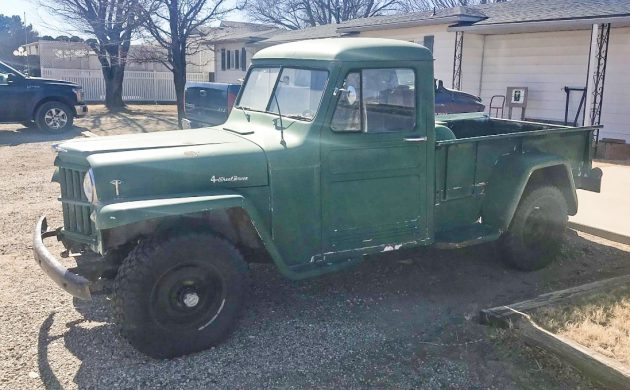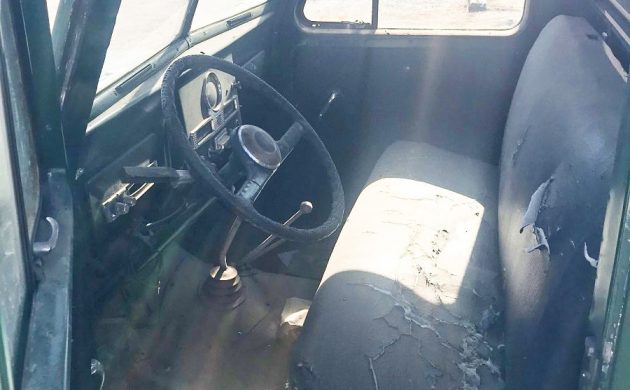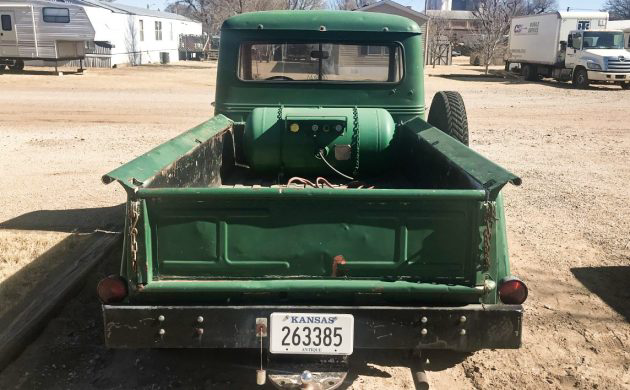Growing up, my Dad had a Chevy C-10 truck that ran on LP (liquid propane) and I remember being super intrigued by this idea. He eventually converted it back to gasoline and I helped him with the task. I thought it was going to be a big job, but it was a very simple task. He actually preferred running it on LP, but in our small town, it was easier to fuel up with gasoline. This 1954 Willys-Jeep 4×4 Truck is also running on LP and with fuel prices what they are these days, it might be the way to go! You can take a closer look at it here in the Barn Finds Classifieds or here on eBay and it’s located in Liberal, Kansas.
If I remember correctly, swapping to LP just required a propane carburetor, the LP tank, and the required hose. My Dad’s truck was set up with LP because it was equipped with a truck-mounted vacuum for cleaning furnaces. Since it was typically parked right next to someone’s house, you had to think about where the exhaust was pointed, well at least with gasoline. Converting it back was as simple as removing the LP components, installing the stock carburetor and hooking the dual fuel tanks back up. There’s no word on why this Jeep was converted, but the seller states that it’s equipped with the Hurricane 6-cylinder engine. Perhaps it was used in areas where exhaust gases were of concern or maybe it was used on the farm and filling up LP was easier than gasoline? Switching it back to run on gasoline shouldn’t be a challenge, but I would try running LP at first to see if it’s cheaper to run.
The seller doesn’t offer much information to go off of. They note that the truck has new brakes and tires, so I assume that means it’s a driver. The body is looking a little dinged up, but I don’t see any rust issues. From what can be seen, the interior looks usable, but it’s going to need a seat cover or new seat upholstery. I love how simple these trucks were, so as long as it’s complete, it shouldn’t be too difficult to fix up.
It would be nice to have a bit more information on the truck’s history and condition, but these 4×4 trucks are getting hard to find in solid condition. If this one is a driver and doesn’t have any rust issues, it would definitely be worth taking a closer look and making the seller an offer! So, if you purchased this truck, would you leave it running on LP or would you switch back to gasoline?






I like
Sweet old truck. Would love this for tooling around the lake or the occasional trail.
In the mid 80’s, I bought a ’54 Willys wagon that had a SBC, and was a crummy build ( I later found out) I saw’r a Willys pickup like this, a ’51 in a front yard with a huge plow, $500 bucks, I think. Had 19K miles, had a non-stock hole in the block, all the guy did was plow his long driveway( for like 40 years) until the motor blew. I didn’t want the plow, when he cut it off, the truck came back to original height( it weighed a ton) and I put everything from the wagon into the pickup. It was my daily driver and a fun truck. The problem here, like all vintage trucks, is gearing. With 4:88 gears,( sometimes 5:13’s) 45 mph was about it, and the SBC didn’t like that. I found out, Wagoneer 4:11 rear axle would work, but something with the front springs, wouldn’t accept the front axle, so I had like 4:11’s in the back, and 4:88 in the front, which made it more roadworthy, but couldn’t use the 4 wheel drive, which was fine by me, I never used it off road anyway. Except for minor changes, the Willys pickup remained unchanged until 1964 when they stopped US production. The ’54 here had a different grill,( 3 horizontal bars instead of 5) a big back window, and the model number changed from 475 to 6-226 with the introduction of the 6 cylinder. Overseas I think, went into the 70’s. It’s a great find, the color may suggest a municipal vehicle, and a lengthy list of updates awaits the next owner to bring it up to todays standards, and that won’t come cheap.
I did not see a price for this ride. It sure would look good next to my 2022 Willys Gladiator . Wish Stellantis would build a 2 Door Version of the Gladiator with 2 wheel drive similar to the ride featured in this article. .The local party store had a 2 Door Station Wagon that they used to delivery beer and cigarettes to the neighbor in the same color green.
Propane IS NOT less expensive than gasoline as a motor fuel. Propane coats about what a gallon of diesel runs now.
Propane “boils” at about -32 degrees Fahrenheit. It also contains some water vapor (as well as some traces of light oils, so you might see some blue smoke out of your exhaust pipe – usually not from the rings, so a leak down test is usually good practice on an unfamiliar vehicle fueled by propane). A bypass coolant line has to preheat the fuel (usually at a regulator) going to the mixer so the fuel can vaporize.
You need to let the engine warm up, especially in cold weather/winter operations so the throttle plate (or more likely, the orifice in the regulator) won’t freeze over.
So, why use propane? First, it’s a vapor fuel, so getting a perfect homogeneous mixture is much easier with a propane mixer than gasoline carburetor (especially with a “feedback” type mixer). And since the fuel is already a vapor when it gets to the mixer, manifold heat is not needed. Tunnel Rams, Cross Rams, Air Gap manifolds and Single Plane manifolds are welcome, as are headers on any inline 6, without drivability issues.
Second, the (anti-knock) Octane rating of Liquid Propane Gas is 108, so it you were going to turbocharge or supercharge, propane motor fuel is the perfect choice. It also contains less carbon, so it pollutes less (including your engine’s lube oil – you might want to have an oil analysis done to see if you can extend time and mileage between oil changes).
Fuel us usually available at a corporate U-Haul stores and propane companies.
But, it you get a Bi-Fuel (usually misnamed “Dual-Fuel”) Kit, the mixer can sit right over the current carburetor or Throttle Body Injector and you’ll need a “lift solenoid” and a propane fuel “lockout” so you can run on either Gasoline or Propane and really extend your vehicle’s range.
That was a great post, but probably could be summed up as, the guy probably worked for a propane dealer and got free fuel. I remember, in the 50’s and 60’s, LP was not widely used, almost a by-product of crude oil, everything was fuel oil and when a new well was tapped, countless gallons(?) of LP blew into the air, I think,and for the record, propane is more on par with gasoline, at around $4.29/gal as diesel in my area is $1.50/gal. more than gas.
When switching from propane to gas it’s a good idea to change spark plugs and adjust timing. Propane generally runs a hotter plug and more advanced timing
What’s your experience with any MPG difference between gas and LPG?
If I recall, propane has less BTU per gallon so you get lower efficiency so you can’t go as far on a gallon of propane as you can on gasoline.
Thank you, Steve Brown. I thought that’s what I remembered but couldn’t recall why the conversions weren’t and didn’t become more prevalent.
WAY back in the 60’s Eastern Oregon farmers converted lots of equipment over to LP. Tractors, balers, swathers, and eventually their personal pickups were changed. I have seen engines at the end of their long hard service life torn down and look like new inside. Squeeky clean, no carbon or deposits at all. :-) Terry J